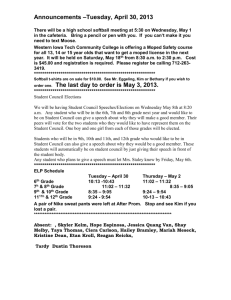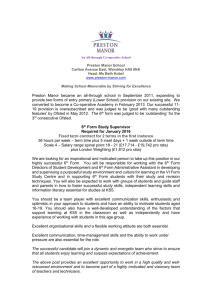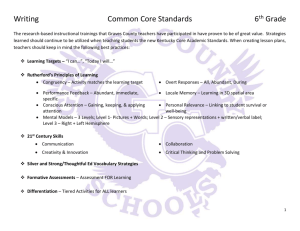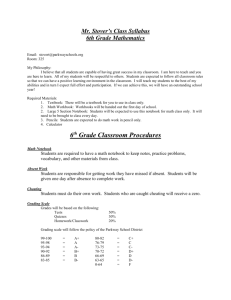6th Body Systems packet
advertisement
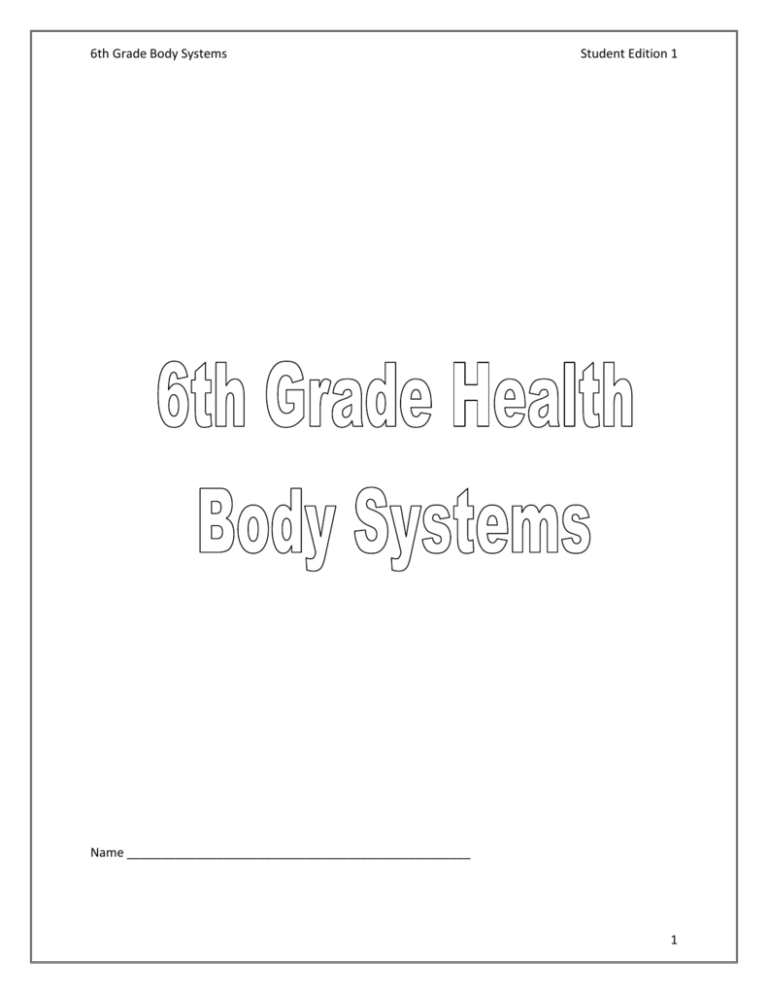
6th Grade Body Systems Student Edition 1 Name __________________________________________________ 1 6th Grade Body Systems Student Edition 2 Lesson Topic Day 1 2 3 4 5 6 7 8 9 10 Intro and Integumentary System Nervous System Skeletal System Muscular System Circulatory System Respiratory System Digestive System Urinary System Endocrine System Review and Assessment 1 1 1 1 1 1 1 1 1 1 2 6th Grade Body Systems Student Edition 3 Life Skill: Vocabulary: I will care for my body systems. Body System Nervous System Circulatory System Respiratory System Skeletal System Muscular System Integumentary System Digestive System Urinary System Endocrine System Have you ever watched an automobile racer? To prepare for a race, the racing team works closely together. Some members of the team care for the car’s engine. Other members are responsible for changing tires and pumping fuel at pit stops. The driver’s responsibility is to control the car while going as fast as possible around the track. All members of the team must work together to have a winning performance. Your body systems also must work together for a top performance. This lesson will explain: How the Body Systems Work Together Ways to Care for Each Body System 3 6th Grade Body Systems Student Edition 4 How the Body Systems Work Together shaped for the task they perform. For example, skin cells are flat and thin and fit tightly together. They make up skin tissue which has a flat and thin appearance. Bone cells have a tough coating. They make bone tissue firm and strong to support the body. Your body is made up of cells, tissues and organs. Together they form body systems. All the body systems work together to keep you healthy and alive. What You Should Know About Organs What You Should Know About Cells A cell is the smallest living part of the body. There are many different kinds of cells in your body. Your muscles are made of muscle cells. Bones are made of bone cells. Different kinds of cells have different shapes and perform different tasks. All cells have three parts to their structure. The cell membrane is the thin outer covering of the cell that holds it together. The cell membrane allows water and nutrients inside the cell. It keeps out anything which might harm the cell, such as germs. The nucleus (NOO∙klee∙uhs) is the part of the cell that controls its activities. The nucleus tells the cell what to do. The cytoplasm (SY∙tuh∙pla∙zum) is the inside material where cell actions take place. An organ is a group of tissues that work together. There are many organs in the body that perform specific tasks. Your heart is an organ that pumps blood to body cells. Your brain is an organ that directs body activities. Your ears are organs that enable you to hear. What You Should Know About Body Systems A body system is a group of organs that work together to perform certain tasks. Each body system performs tasks no other body system does. Some organs belong to more than one body system. All the body systems work together to keep you healthy and alive. What You Should Know About Tissues A tissue is a group of like cells that work together. Cells that make up tissues are 4 6th Grade Body Systems Student Edition 5 Name: _____________________________________________________________________ How Body Systems Work Together What should you know about cells? A cell is _______________________________________________________________________ ______________________________________________________________________________ The cell membrane ______________________________________________________________ ______________________________________________________________________________ The nucleus ____________________________________________________________________ ______________________________________________________________________________ The cytoplasm __________________________________________________________________ ______________________________________________________________________________ What should you know about tissues? A tissue is _____________________________________________________________________ ______________________________________________________________________________ Cells that make up tissues are _____________________________________________________ ______________________________________________________________________________ What should you know about organs? An organ is ____________________________________________________________________ ______________________________________________________________________________ There are many organs in your body that ____________________________________________ ______________________________________________________________________________ What should you know about body systems? A body system is ________________________________________________________________ ______________________________________________________________________________ Each body system performs __________ no other body system does. Some _________ belong to more than one body system. All the _________________________ work together to keep you _________________________ and _________________________. (Smallest) ____________________, ____________________, ____________________ (Largest) 5 6th Grade Body Systems Student Edition 6 6 6th Grade Body Systems Student Edition 7 The Integumentary System The Integumentary (in∙teh∙gyuh∙MENT∙uh∙ree) system is the body system made up of parts that cover and protect the body. Skin, hair, nails and glands in the skin are parts of this body system. The skin is the largest organ in the body. It has many important functions. The skin protects body parts against injury. It serves as a protective layer that keeps microorganisms from entering the body. Sweat glands are glands in skin that help maintain healthful body temperature. Sweat glands in the skin produce perspiration when you body is warm. Your body is cooled as the water in sweat evaporates from the skin. The skin contains melanin. Melanin (MEL∙uh∙nin) is a substance that protects skin and gives it color. The greater the amount of melanin in skin, the darker your skin color. Melanin protects the skin from the ultraviolet rays of the sun. These rays are harmful because they can cause skin cancer. Hair is another part of this body system. Hair is hardened dead cells. Hair protects your skin from the ultraviolet rays of the sun. Hair also helps maintain body temperature. Nails are part of this body system and are made of dead cells. Ways to Take Care of Your Integumentary System: Bathe or shower each day to remove germs, dirt and oil from skin. Keep hair clean. Use a special shampoo if you have dandruff (flakes of dead skin cells on the scalp). Wear a sunscreen with a Sun Protective Factor of at least 15 and clothing to protect skin from UV rays. See a physician if you have a skin rash. 7 6th Grade Body Systems Student Edition 8 Name: _____________________________________________________________________ The Integumentary System 1. The Integumentary system is the body system made up of ________________________ _______________________________________________________________________. 2. Parts of this system include: a. _________________________. b. _________________________. c. _________________________. d. ___________________________________. 3. The _______________ is the largest organ in the body. 4. Sweat glands are glands in the skin that _______________________________________ _______________________________________________________________________. These glands produce ____________________ when the body is warm. Your body is cooled as the water in sweat ____________________. 5. Melanin is a _____________________________________________________________. Melanin protects the skin from the harmful ultraviolet rays of the sun. 6. Care for the Integumentary System by: a. __________________________________________________________________ b. __________________________________________________________________ c. __________________________________________________________________ d. __________________________________________________________________ e. __________________________________________________________________ 8 6th Grade Body Systems Student Edition 9 The Nervous System The nervous system is the body system for communication and control. It is composed of neurons. A neuron (NOO∙rahn) is a mass of nerve cells. The parts of the nervous system include the brain, spinal cord, and the nerves that branch off the spinal cord. The brain is an organ that is the control center for the body. The cerebrum (suh∙REE∙bruhm) is the part of the brain where thinking takes place. The cerebellum (ser∙uh∙BEL∙uhm) is the part of the brain that helps muscles work together. The brain stem is the lowest part of the brain through which messages moving between your brain and body pass. The brain stem controls the functions of inner organs. Critical life functions, such as maintaining heartbeat, take place in the brain stem. The spinal cord is a thick band of nerve cells through which messages enter and leave the brain. The spinal cord is soft and must be protected by the spine. The spine is a column of bones in the back. The spinal cord connects the brain with nerves throughout the body. Nerves send messages to the brain by way of the spinal cord. Sometimes, the spinal cord works without the help of the brain. A reflex action is a quick movement that is not directed by the brain. For example, you may remove your hand quickly from a hot object. Ways to Take Care of Your Nervous System: 1. 2. 3. 4. 5. Use a safety restraint system when riding in a car. Wear a safety helmet for sports. Follow safety rules. Avoid alcohol, other drugs and poisons. Get plenty of rest and sleep. 9 6th Grade Body Systems Student Edition 10 Name: _____________________________________________________________________ The Nervous System 1. The nervous system is the body system for _____________________________________ _______________________________________________________________________. 2. A neuron is ______________________________________________________________. 3. The parts of the nervous system are __________________________________________ _______________________________________________________________________. 4. The cerebrum is the part of the brain where _________________________ takes place. 5. The cerebellum is the part of the brain that ____________________________________ _______________________________________________________________________. 6. The brain stem is the lowest part of the brain __________________________________ _______________________________________________________________________. 7. The spinal cord is a ________________________________________________________ _______________________________________________________________________. 8. The spinal cord is __________ and must be protected by the ______________________. 9. Care for the Nervous System by: a. _________________________________________________________________. b. _________________________________________________________________. c. _________________________________________________________________. d. _________________________________________________________________. e. _________________________________________________________________. 10 6th Grade Body Systems Student Edition 11 Name: _____________________________________________________________________ Please label the following parts of the nervous system: Brain Stem Cerebellum Cerebrum Spinal Cord 11 6th Grade Body Systems Student Edition 12 Name: _____________________________________________________________________ Please label the following parts of the nervous system: Nerves Spinal Cord Nerve Cell Brain Brain Stem 12 6th Grade Body Systems Student Edition 13 The Skeletal System The skeletal system is the body system that serves as a support framework. This body system holds the body together, protects inner body parts, and helps with movement. There are 206 bones in the skeletal system. Bones help the body move in the following way. Almost every bone is connected to at least one other bone by a joint. A joint is a point at which two bones meet. A hinge joint allows bones to move back and forth. Your elbow is a hinge joint. A ball and socket joint allows bones to move in full circle. Your shoulder is a ball and socket joint. A fixed joint allow no movement. The skull is made up of fixed joints. Cartilage (Kar∙tuh∙lij) is soft material on the end of bones. Cartilage protects your bones by keeping them from rubbing together. Take Care of Your Skeletal System: 1. Exercise to make bones thicker and stronger. 2. Wear comfortable shoes with good arches. 3. Eat plenty of foods with calcium, phosphorus and vitamin D to make bones strong. 4. Use correct posture to support the spinal column. 13 6th Grade Body Systems Student Edition 14 Name: _____________________________________________________________________ The Skeletal System 1. The skeletal system is the body system that ____________________________________ _______________________________________________________________________. 2. This system holds the ______________________________, protects ________________ _____________ and ______________________________________________________. 3. There are __________ bones in the skeletal system. 4. A joint is a ______________________________________________________________. 5. A _____________________________ allows bones to move back and forth; a _____________________________ allows bones to move in a full circle; and a fixed joint allows no movement. 6. Cartilage is ______________________________________________________________. 7. Care for the Skeletal System by: a. _________________________________________________________________. b. _________________________________________________________________. c. _________________________________________________________________. d. _________________________________________________________________. 14 6th Grade Body Systems Student Edition 15 Name: _____________________________________________________________________ Please label the following parts of the nervous system: Backbone (Vertebrae) Collarbone (Clavicle) Fingers (Phalanges) Hip Bone (Pelvis) Jaw (Mandible) Kneecap (Patella) Rib (Rib) Shinbone (Tibia) Shoulder (Scapula) Skull (Cranium) Thigh Bone (Femur) 15 6th Grade Body Systems Student Edition 16 The Muscular System The muscular system is the body system that helps you move and maintain posture. Voluntary muscles are muscles that you control. The muscles used when you stand are voluntary muscles. Involuntary muscles are muscles that you do not consciously control. Your heart beats without you having to control it. Some muscles stretch across joints. Tendons (TEN∙duhnz) are tough tissue that connect muscles to joints. Muscles work in pairs to move bones. One muscle contracts and shortens while the other relaxes and lengthens. Hold one arm and hand out straight. Place the other hand around the muscle above your elbow. Which muscle contracted? Which muscle relaxed? Ways to Take Care of Your Muscular System: 1. 2. 3. 4. 5. Lift objects by bending your knees and keeping the back straight to prevent injury. Choose exercises for different muscle groups. Warm up before hard exercise to prevent injury. Sleep on a firm mattress. Eat food with protein to help with muscle cell growth. 16 6th Grade Body Systems Student Edition 17 Name: _____________________________________________________________________ The Muscular System 1. The muscular system is the body system that ___________________________________ _______________________________________________________________________. 2. The two types of muscles are a. ______________________________ b. ______________________________ 3. ______________________________ muscles are muscles that you control, for example, your bicep. 4. ______________________________ muscles are muscles that you DO NOT consciously control, for example, your heart. 5. Tendons are ______________________________ that connect _______________________________________. 6. Muscles work in ____________________ to move bones. When one muscle contracts and shortens, the other ____________________ and ____________________. 7. You have about __________ muscles in your body. 8. Care for the Muscular System by: a. _________________________________________________________________. b. _________________________________________________________________. c. _________________________________________________________________. d. _________________________________________________________________. e. _________________________________________________________________. 17 6th Grade Body Systems Student Edition 18 Name: _____________________________________________________________________ Please label the following parts of the muscular system: Gastrocnemius Quadricep Bicep Tricep Abdominals Trapezius Deltoid Pectoralis Major 18 6th Grade Body Systems Student Edition 19 The Circulatory System The circulatory system is the body system that transports oxygen, food and waste through the body. The circulatory system consists of blood, blood vessels and the heart. You have about one gallon of blood in your body. Plasma is the liquid part of the blood. Three main kinds of cells are found in plasma. Red blood cells are blood cells that carry oxygen to body cells and carbon dioxide away from body cells. White blood cells are blood cells that fight germs that cause infection and illness. Platelets are blood cells that help blood clot. A scab is a dried clot. The heart is a muscular organ that pumps blood to the body. Blood vessels transport blood through the body. An artery (AR∙tuh∙ree) is a blood vessel that carries blood away from the heart. A vein (VAYN) is a blood vessel that returns blood to the heart. A capillary (KA∙puh∙lehr∙ee) is a tiny blood vessel that connects arteries and veins. Ways to Take Care of Your Circulatory System: 1. 2. 3. 4. 5. Exercise regularly to make your heart muscle strong. Keep your arteries clear by eating fewer fatty foods. Do not smoke, to keep your heart from working too hard. Maintain a healthful weight. Keep stress low to keep blood pressure normal. 19 6th Grade Body Systems Student Edition 20 Name: _____________________________________________________________________ The Circulatory System 1. The circulatory system is the body system that __________________________________ _______________________________________________________________________. 2. The parts of the circulatory system are a. ______________________________________ b. ______________________________________ c. ______________________________________ 3. You have about __________ of blood in your body. 4. Plasma is the _________________________________ ___________________________________________. 5. List the three main kinds of cells in plasma: a. ____________________________________________ b. ____________________________________________ c. ____________________________________________ 6. The heart is a muscle organ that ____________________________________________. 7. An artery is a blood vessel that carries blood _______________ from the heart. 8. A vein is a blood vessel that _______________ blood to the heart. 9. Care for the Circulatory System by: a. _________________________________________________________________. b. _________________________________________________________________. c. _________________________________________________________________. d. _________________________________________________________________. e. _________________________________________________________________. 20 6th Grade Body Systems Student Edition 21 Label the following parts: Heart Vein Artery Capillary 21 6th Grade Body Systems Student Edition 22 Name: _____________________________________________________________________ 22 6th Grade Body Systems Student Edition 23 The Respiratory System The respiratory system is the body system that helps the body use air that is inhaled. When you inhale, air enters the nose and mouth. The trachea (TRAY∙kee∙uh) is the windpipe through which air travels to the lungs. The trachea divides into two bronchial tubes. The bronchial (BRAN∙kee∙uhl) tubes are two short tubes through which air enters the lungs. Inside the lung, these tubes branch into smaller tubes. The alveoli (al∙vee∙OH∙ly) are small air sacs through which oxygen enters the capillaries. Then red blood cells carry oxygen to the body cells and pick up carbon dioxide. The quality of the air you breathe is important. The hairs in your nose trap particles from the air. Mucus in your nasal passages trap germs and particles. Cilia (SI∙lee∙uh) are tiny hairs that line the air passages. Ways to Take Care of Your Respiratory System.: 1. 2. 3. 4. 5. Stay away from polluted air. Do not smoke or breathe tobacco smoke. Exercise to strengthen the muscles needed for breathing. See a physician when you have a respiratory infection. Use correct posture to allow the lungs the space needed to breathe deeply. 23 6th Grade Body Systems Student Edition 24 Name: _____________________________________________________________________ The Respiratory System 1. The respiratory system is the body system that _________________________________ _______________________________________________________________________. 2. The trachea is the ___________________ through which air travels to the lungs. 3. The bronchial tubes are ___________________ through which ____________________ _______________________________________________________________________. 4. The alveoli are ___________________ through which ____________________________ _______________________________________________________________________. 5. Which type of blood cell carries the oxygen to the body cells and picks up carbon dioxide? ____________________ 6. The ____________________ of air you breathe is important. 7. Cilia are ________________________________________________________________. 8. Care for the Respiratory System by: a. _________________________________________________________________. b. _________________________________________________________________. c. _________________________________________________________________. d. _________________________________________________________________. e. _________________________________________________________________. 24 6th Grade Body Systems Student Edition 25 Name: _____________________________________________________________________ 25 6th Grade Body Systems Student Edition 26 The Digestive System The digestive system is the body system that breaks down food so that it can be used by the body. Food provides your body with nutrients. A nutrient is a substance in food that helps with growth and repair of cells, helps with body processes and gives you energy. Digestion begins in the mouth. The salivary (SA∙luh∙vehr∙ee) glands are two glands that produce saliva. Saliva is a liquid that softens food. The action of chewing combined with saliva moistens food and breaks it into smaller pieces. Food passes from the mouth into the esophagus. The esophagus (i∙SAH∙fuh∙guhs) is a tube through which food passes into the stomach. The stomach is the organ that releases digestive juices to break down food. Food passes from the stomach to the small intestine. The small intestine is the organ in which most digestion takes place. Digestive juices from glands help with this process. The pancreas (PAN∙kree∙uhs) is a gland that secretes insulin and juices that break down some foods. It secretes a hormone that regulates the blood sugar level. Insulin helps your body use sugar. The liver is a gland that produces bile. Bile helps break down fats. The gallbladder (GAWL∙blader) is an organ that stores bile. Food that is broken down enters the blood through capillaries in the small intestine. Food that is not broken down passes to the large intestine. The large intestine is the organ in which undigested food is stored until it leaves the body. A bowel movement is when undigested food leaves the body. Eating fresh fruits and vegetables helps you have a daily bowel movement. Take Care of Your Digestive System by: 1. Chew food thoroughly before swallowing. 2. Eat fresh fruits and vegetables to have a daily bowel movement. 26 6th Grade Body Systems Student Edition 27 Name: _____________________________________________________________________ The Digestive System 1. The digestive system is the body system that ___________________________________ _______________________________________________________________________. 2. Food provides your body with nutrients that help with ___________________ and ___________________ of cells, help with body processes and give you energy. 3. Saliva is a _______________________________________________________________. 4. The esophagus is a _______________ that passes food from your mouth to your ____________________. The stomach is the organ that ____________________ digestive juices to break down food. 5. Next, the food travels to the __________________ , where most of the digestion takes place. 6. The large intestine is the organ in which undigested food is ____________________ until it leaves the body. 7. Care for the Digestive System by: a. _________________________________________________________________. b. _________________________________________________________________. 27 6th Grade Body Systems Student Edition 28 Name: _____________________________________________________________________ 28 6th Grade Body Systems Student Edition 29 The Urinary System The urinary system is the body system that removes liquid wastes from the body. As body cells use nutrients, they produce waste. The waste products pass into the blood for removal from the body. The blood circulates through two kidneys. A kidney is an organ through which blood circulates as wastes are filtered. Urine is the liquid waste that collects in the urinary bladder. When the bladder is full with urine, nerve signals are sent to the brain. A message from the brain indicates that it is time for the bladder to be emptied. The urethra (yu∙REE∙thruh) is the tube through which urine leaves the body during urination. There’s Water in Those Fruits and Veggies You can replace water lost through urination in many ways. You can drink at least six to eight glasses of water a day. Water can be replaced by drinking fruit juices or eating fresh fruits. Vegetables, such as celery and lettuce, also are a source of water. Ways to Take Care of Your Urinary System 1. Replace water lost through urination with at least six to eight glasses of water per day. 29 6th Grade Body Systems Student Edition 30 Name: _____________________________________________________________________ The Urinary System 1. The urinary system is the body system that ____________________________________ _______________________________________________________________________. 2. As body cells use nutrients, they produced __________________ into the blood. 3. A kidney is an organ through which ___________________________________________ _______________________________________________________________________. 4. Urine is the _____________________________________________________________. 5. When the bladder is full, nerve signals are sent to the _____________________. A message from the brain indicates that it is time for the bladder to be emptied. 6. The urethra is the ________________________________________________________. 7. Care for the Urinary System by: a. _________________________________________________________________. 30 6th Grade Body Systems Student Edition 31 Name: _____________________________________________________________________ 31 6th Grade Body Systems Student Edition 32 The Endocrine System The endocrine system is the body system made up of glands that produce hormones. A hormone is a chemical messenger that regulates body activities. Endocrine glands control many of the changes in the body. Each gland produces a different hormone. Each hormone has a different function. Ways to Take Care of Your Endocrine System 1. Have regular medical checkups. 2. Ask your parents or guardians and doctor questions about your growth. 32 6th Grade Body Systems Student Edition 33 33 6th Grade Body Systems Student Edition 34 34 6th Grade Body Systems Student Edition 35 35 6th Grade Body Systems Student Edition 36 36 6th Grade Body Systems Student Edition 37 37

